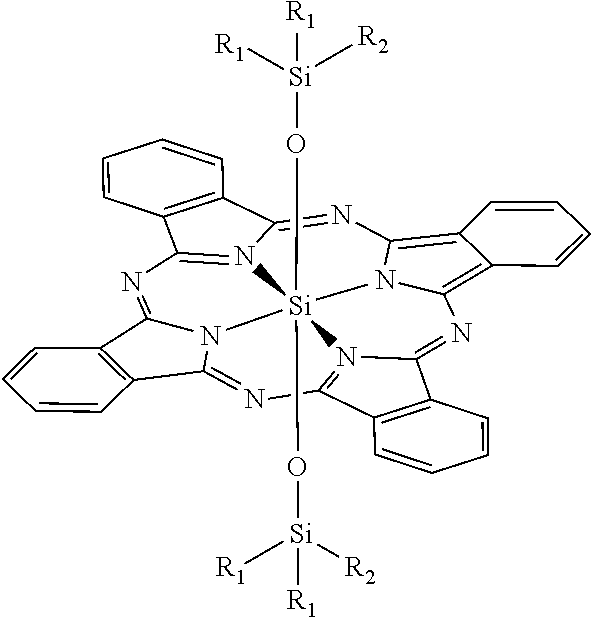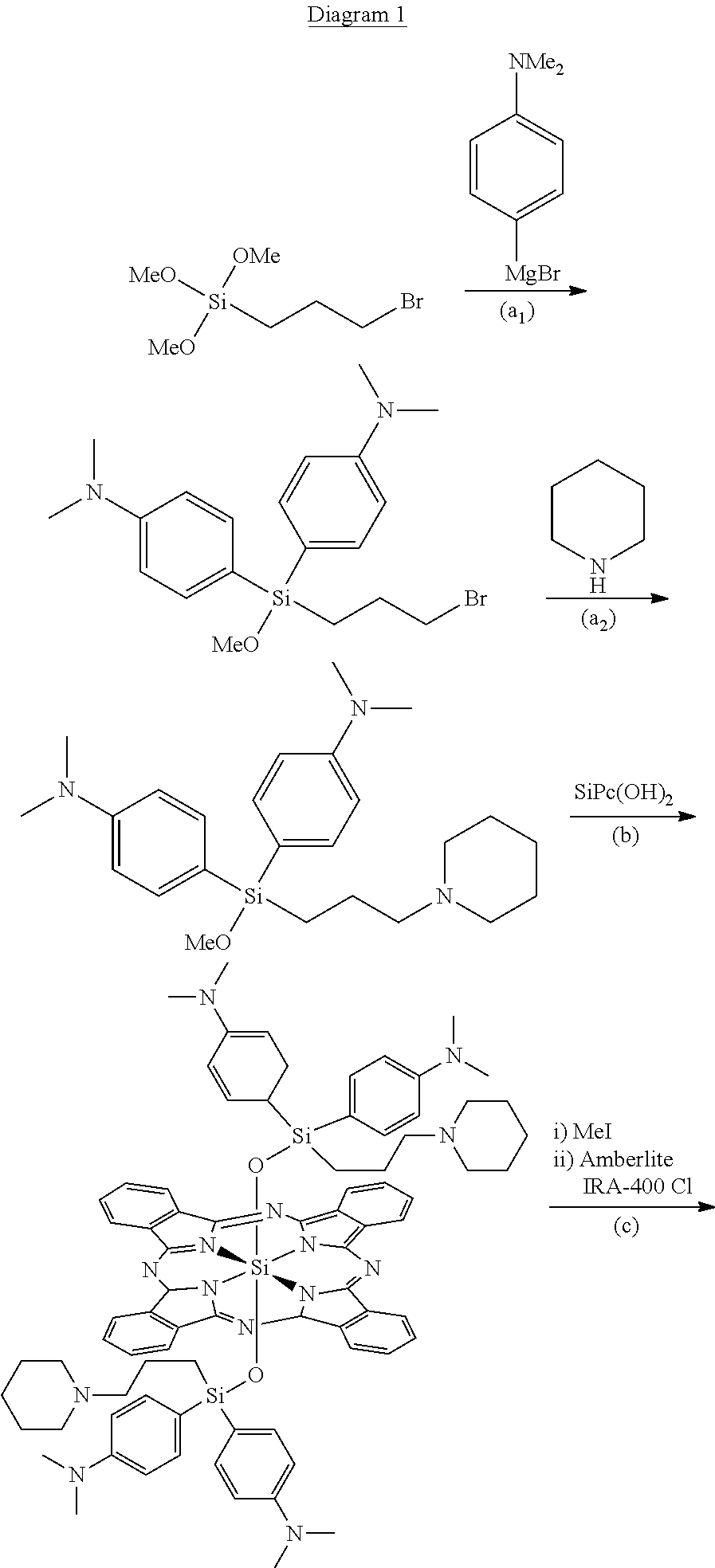Novel phthalocyanine derivatives for therapeutic use
- Summary
- Abstract
- Description
- Claims
- Application Information
AI Technical Summary
Benefits of technology
Problems solved by technology
Method used
Image
Examples
example i
Synthesis of {bis-[bis-(p-N,N,N-trimethylammoniumphenyl)]-3-(N-methyl-piperidine-1-ium)propylsilyloxy}silicon(IV) phthalocyanine hexachloride (Compound 1)
a1) Synthesis of bis-(p-N,N-dimethylaminophenyl)-3-bromopropylmethoxy silane
[0023]To a solution of 3-bromopropylmethoxy silane (365 mg, 1.5 mmol) in anhydrous tetrahydrofuran (8 mL) are added, in an inert atmosphere, 12 mL of a solution 0.5 M of 4-N,N-dimethylaminophenyl magnesium chloride (6 mmol). The solution is agitated at 90° C. for 2.5 hours. The reaction mixture is diluted with 200 mL of ethyl ether and filtered through celite. 960 mg of raw product are obtained following evaporation of the solvent. The product was characterized by means of 1H-NMR analysis.
[0024]1H-NMR (300 MHz, DMSO-d6): 7.30-6.59 (m, 8H), 3.49 (t, 2H, J=7.0 Hz), 3.52 (s, 3H), 2.88 (s, 12H), 1.76 (m, 2H), 1.08 (m, 2H).
a2) Synthesis of bis-(p-N,N-dimethylaminophenyl)-3-(piperidine-1-yl)propylmethoxy silane
[0025]To a solution of 900 mg of raw bis-(p-N,N-dimet...
example ii
Synthesis of {bis-[bis-(3-N,N,N-trimethylammoniumpropyl)]propylsilyloxy}silicon(IV) phthalocyanine tetrachloride (compound 2)
a1) Synthesis of 3-N,N-dimethylaminopropyl magnesium chloride
[0038]380 mg (48 mmol) of lithium hydride are added to a solution of 3-chlorine-N,N,-dimethylpropylamine hydrochloride (3.8 g, 24 mmol) in 25 mL of anhydrous tetrahydrofuran. The mixture is agitated at room temperature for 1 hour, following which agitation is stopped and the solid is allowed to settle. Into a round-bottomed, two-necked flask containing 690 mg (29 mmol) of magnesium turnings and 2.0 g (48 mmol) of lithium chloride and dried with vacuum-nitrogen cycles, are added in an inert atmosphere, 12 mL of anhydrous tetrahydrofuran, 0.7 mL of a 1M solution in tetrahydrofuran of diisobutylalluminium hydride and the amine solution, drop by drop. On completion of the addition, the mixture is agitated under reflux for 4 hours. When the reaction mixture is brought back to room temperature, Grignard ti...
example iii
Synthesis of {bis-[bis-(p-N,N,N-trimethylammoniumphenyl)]propylsilyloxy}silicon(IV) phthalocyanine tetrachloride (compound 3)
a) Synthesis of bis-(p-N,N-dimethylaminophenyl)methoxypropyl silane
[0052]Into a round-bottomed, two-necked dried vacuum flask are added, in an inert atmosphere, 205 mg of propyltrimethoxy silane (1.25 mmol) and 10 mL of a 0.5 M solution in tetrahydrofuran of 4-N,N-dimethylaminophenyl magnesium chloride (5 mmol). The solution is agitated at 90° C. for 2 hours. The reaction mixture is diluted with 150 mL of ethyl ether and filtered through celite. 450 mg of raw product are obtained following evaporation of the solvent. The product was characterized by means of 1H-NMR analysis.
[0053]1H-NMR (300 MHz, DMSO-d6): 7.28 (m, 4H), 6.70 (m, 4H), 3.39 (s, 3H), 2.86 (s, 12H), 1.29 (m, 2H), 0.99-0.82 (m, 5H).
b) Synthesis of {bis-[bis-(p-N,N-dimethylaminophenyl)]propylsilyloxy}silicon(IV) phthalocyanine
[0054]In a round-bottomed, two-necked 100 mL flask, a mixture of 114 mg of...
PUM
 Login to View More
Login to View More Abstract
Description
Claims
Application Information
 Login to View More
Login to View More - R&D
- Intellectual Property
- Life Sciences
- Materials
- Tech Scout
- Unparalleled Data Quality
- Higher Quality Content
- 60% Fewer Hallucinations
Browse by: Latest US Patents, China's latest patents, Technical Efficacy Thesaurus, Application Domain, Technology Topic, Popular Technical Reports.
© 2025 PatSnap. All rights reserved.Legal|Privacy policy|Modern Slavery Act Transparency Statement|Sitemap|About US| Contact US: help@patsnap.com



